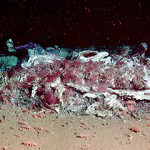Kim didn’t miss much. She went into Final Jeopardy with $15,000 and won the match by a scant $1 by correctly identifying the world’s largest invertebrate (answer: “What is a giant squid?”).
But was she right?
There seems to be considerable debate about this.
Steve O’Shea (giant invertebrate expert extraordinaire) says this (with his permission)…
Architeuthis is frequently reported to attain a total length of 60 ft. The largest specimen known washed ashore on a New Zealand beach, Lyall Bay (Wellington) in the winter of 1887. It was a female and “in all ways smaller than any of the hitherto-described New Zealand species” (Kirk 1887); it measured 55 feet 2 inches in total length, exaggerated by great lengthening (stretching like rubber bands) of the very slight tentacular arms; its mantle length was 71 inches (1.8 m). A comparable-sized female (ML 1.8 m) measured post mortem and relaxed (by modern standards) would have a total length of ~ 32 feet.
Mantle length (as opposed to total length) is the standard measure in cephalopods. Architeuthis is not known to attain a mantle length in excess of 2.25 m. Standard Length (SL) is the length of a squid excluding the tentacles; in Architeuthis this measure very rarely exceeds 5 m. The rest of the animal’s length, to a total length of 13 m, is made up of the two long tentacles. Of 121 specimens that we have examined, none has exceeded this figure
But wait, what about the Colossal Squid?
No mature Mesonychoteuthis hamiltoni is known. Based on the size of beaks recovered from sperm whale stomach contents it is estimated that it attains a mantle length of 2–4 m, which would render it considerably larger than Architeuthis.
An online forum challenges O’Shea’s assumption…and O’Shea responds.
So it appears that for mantle length (and mass) M. hamiltoni make take the prize. If you use total length (mantle plus tentacles) A. dux may be longer.
I agree with O’Shea in his own words…
I’ll ask you. What would you sooner be in the water with. A 13m Architeuthis (total length) weighing 275kg, or a 5m (total length) SUBMATURE Mesonychoteuthis weighing ~ 300kg? That weight has to be distributed somewhere, and that is in the BODY of the animal; it is stuffing enormous. It doesn’t have pathetic, feeble tentacles to stretch out like Architeuthis; this animal attains a massive size that exceeds that of Architeuthis in mantle and standard length.






Am I the only one who finds interchangeable usage of feet and meters annoying? :>
There is also another giant invertebrate which surpasses even all of the “lesser giants” among the cephalopods, but usually nobody thinks on it. Giant clams were recorded with record weights of more than 250 kg, what´s already quite close to the largest confirmed weights of Architeuthis. There are also reports of weights up to 400 kg, but I am somewhat sceptical about them. Of course the weight of the soft body is only a surprisingly tiny fraction of the total weight of the giant clam.